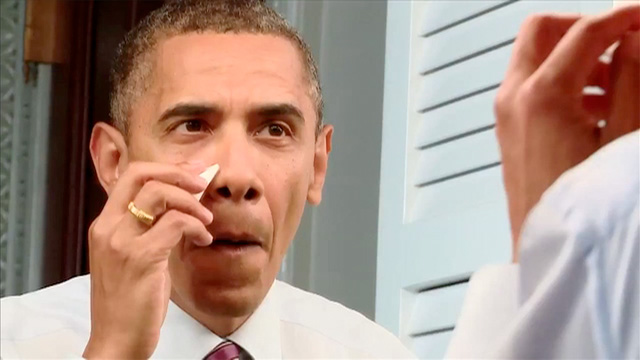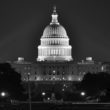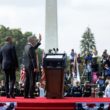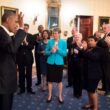(In a video skit, President Barack Obama played Daniel Day-Lewis playing Obama, reversing the conventions and expectations of the minstrel tradition of “blackface.”)
Minstrelsy was America’s most popular entertainment for almost two centuries. It involved white men painting their faces “black” with burnt cork or shoe polish. “Blackface” validated white fantasies of blackness. By mocking chattel slavery and lampooning African Americans’ ability to be full and equal citizens, race minstrelsy was a lens through which white supremacy reimagined the plantation as idyllic and African Americans as childlike, simple, and stupid.
Blackface also secured the place of white ethnics (and other whites) struggling with industrial capitalism in the American racial hierarchy. Blackface was predicated on reinforcing the inferiority of black Americans. By literally “buying into” white racist norms, newly arrived–and not quite fully “white”–European ethnics took a step toward enfranchised whiteness.
Historian Eric Lott suggests that race minstrelsy involved a mix of “love and theft.” Arbitrary categories of racial identity were reinforced culturally and politically to determine the life chances, safety, security, and (quite literally) freedom of human beings. Because it is a quintessentially American cultural practice, blackface is complex, conflicted, and grotesque.
It was brilliant turn of “reverse passing” as well as transgressive and revealing in sharp but quiet ways.
So it should come as no surprise that blackface was and continues to be popular even among African Americans. Tyler Perry and Dirty South rappers like ‘Lil Jon find their precursors in race minstrel performers. The intricacies get weirder.African-American vaudevillians would often have to “double cork” — that is, a black man whose skin was light enough to “pass” as a white man would have to “blacken up” in order to pretend to be a white man in blackface. Limited by the realities of the marketplace and its restraints on black upward mobility, many of these artists made a painful choice to participate in a type of popular entertainment that reinforced the logic of Jim and Jane Crow America.
Double corking highlights the absurdities at the heart of the color line. Blackness was/is a performance. The white gaze reinforced terms of black humanity and made real the fantasy of race minstrelsy. This fantasy helped to legitimate the racial hierarchies of power, privilege, and opportunity that continue even in the era of a post-racial American presidency.
In light of this, it’s clear that President Barack Obama’s performance at the 2013 Washington Correspondents’ Dinner this week was a version of “double corking.” In a video clip, in which filmmaker Steven Spielberg talks about following up his film Lincoln with bio-pic of Obama, the president pretends to be actor Daniel Day-Lewis who is pretending to be Obama. It was brilliant turn of “reverse passing” as well as transgressive and revealing in sharp but quiet ways.
Obama chose to be silent on matters of black uplift, yet the radical right viciously savages him whenever it can as a black usurper longing to “oppress” white people. The president can’t even make a factual observation about his own racial identity without being attacked for having the poor taste of reminding people that he is an African American.
For this reason, Obama has been limited to symbolic gestures of racial solidarity. He can give a tour to a black “Kid President.” He can honor the Tuskegee Airmen. He can put a bust of Dr. King in the Oval Office. But that’s it. His “all boats float” approach to public policy has meant that the needs of African Americans have gone unaddressed. The “price of the ticket” (to borrow a phrase from Fredrick Harris Jr.) for black folks’ support of Obama has been very high.
Even so, Obama has faced down questions of race on occasion, the most prominent of which was the “race speech” in 2008. That speech was deeply problematic as it tried to assure white voters that he was the “right type of black” who wouldn’t hold them accountable for white racism. His speech at the 2013 Washington Correspondents’ Dinner was better.
In it, he subtly revealed his deeper thoughts on race and on the white racial hostility of some in the American public toward the twin and interconnected facts of his personhood and legitimacy. But it wasn’t Obama saying this. It was Obama in “double cork,” reverse passing. Only by pretending to be a white actor who was pretending to be America’s first black president was America’s first black president free allude to the white stereotype of the “angry black men” that binds him.
For this reason, Obama’s minstrel routine is deeply troubling. Despite his seat at the apex of state authority, Obama as Obama is incapable of speaking truth to power. A white president would have more leeway, but a black president like Obama must “blacken up” by putting on the “double cork” if he wants to talk in a truth-telling way about racial justice.
History has weight. It is also beset by many cruel ironies.
Chauncey DeVega is an essayist, cultural critic, and host of “The Chauncey DeVega Show” podcast.







0 Comments